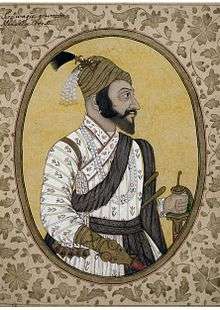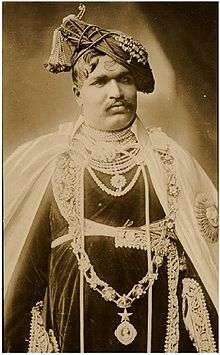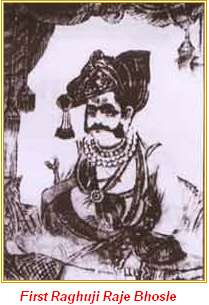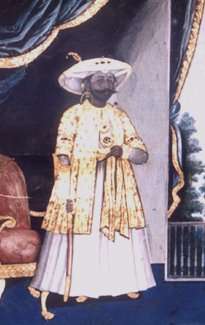Bhonsle
- Bhosle and Bhosale lead here. For other uses, see Bhosle (disambiguation) and Bhosale (disambiguation)
| Bhonsle | |
|---|---|
| Maratha clan | |
| Ethnicity | Indian |
| Location | Maharashtra, Tamil Nadu |
| Language | Marathi |
The Bhonsle (or Bhonsale, Bhosale, Bhosle)[1] are a prominent group within the Maratha clan system. Traditionally a warrior clan,[2][3] some members served as rulers of several states in India, the most prominent being Shivaji, the founder of the Maratha Empire which displaced the Moghul Empire as the preeminent political and military power in India. His successors ruled as chhatrapatis (maharajas) from their capital at Satara, although de facto rule of the empire passed to the Peshwas, the Maratha hereditary chief ministers, during the reign of Shahu I. In addition to the Bhonsle Chhatrapatis of Satara, rulers of the Bhonsle clan established themselves as junior branch of Chhatrapatis at Kolhapur, and as Maharajas of Nagpur in modern-day Maharashtra in the 18th century.
After the British defeat of the Marathas in the Third Anglo-Maratha War in 1818, the four Bhonsle dynasties continued as rulers of their princely states, acknowledging British suzerainty while retaining local autonomy. The states of Satara, Thanjavur, and Nagpur came under direct British rule in the mid-nineteenth century when their rulers died without male heirs, although the British allowed titular adoptions to take place. Kolhapur state remained autonomous until India's independence in 1947, when the rulers acceded to the Indian government.
Akkalkot State,[4] Sawantwadi State[5] and Barshi[6] were amongst other prominent states ruled by the Bhonsles.
Origin
The Bhonsles originated among the populations of the Deccani tiller-plainsmen who were known by the names Kunbi and Maratha.[7] The ancestors of Shivaji were popularly known to be neither Kshatriyas nor of any other twice-born caste, but the cultivators, as Shivaji's great-grandfather was still remembered to have been. The chroniclers of Shivaji and other contemporary writers do not give much information about the ancestors of Shivaji beyond his great-grandfather Babaji.
At the time of coronation of Shivaji, Bhonsles claimed their origin from Suryavanshi Sisodia Rajput.[8][9][10] Allison Busch, Professor at the University of Columbia states that Shivaji was not a Kshatriya as required and hence had to postpone the coronation until 1674 and hired Gaga Bhatt to trace his ancestry back to the Sisodias. While the preparations for the coronations were in process, Bhushan, a poet, wrote a poem about this genealogy claimed by Bhatt in "Shivrajbhushan". Using this example, Busch shows how even poetry was an "important instrument of statecraft" at the time.[11][12] Some scholars suggest that Pandit Gaga Bhatt was secured in charge of authoritatively declaring him a Kshatriya. He was made a compliant, and he accepted the Bhonsle pedigree as fabricated by the secretary Balaji Avji, and declared that Rajah was a Kshatriya, descended from the Maharanas of Udaipur.[13] The Brahman acknowledgement of Kshatriyahood is therefore taken as political. The passage from the Dutch records suggest the plausibility of this argument.[14] The report of Shivaji's coronation in the contemporary Dutch East India Company archives indicates that Shivaji's claim was contested twice at the ceremony itself. Firstly the Brahmins did not want to grant him the status of Kshatriya and then they refused him the recitation of the Vedas, indicating Shivaji was admitted to the fold of the higher varnas as far as the sign of the sacred thread was concerned, but restricted in their use of the concomitant ritual rights including the recitation of the Vedas.[15] Historians such as Surendra Nath Sen and V.K. Rajwade reject the Sisodia origin by citing the temple inscription of Math, dated to 1397 A.D and holds the view that the genealogy was forged by Shivaji's men.[16] According to R.C. Dhere, Bhonsles are descendants of the founder of Shikhar, Balip. He argues that the name Bhonsle is linguistically descended from 'Hoysala'. There is a branch of Bhonsle clan extant in Maharashtra that goes by the name 'Śirsāṭ Bhosale' and Balip's full name, from inscriptional sources cited by Dhere, was 'Baliyeppā Gopati Śirsāṭ'.[17] Some Mudhol firmans in the possession of the Rajah of Mudhol claim the descent of the Ghorpades under the Adil Shahs and the Bhonsles, from the Sisodia Rajputs of Udaipur. However historians consider these firmans spurious as these are the copies (not originals), written by a scholar of Bijapur dated to c.1709, much after the coronation of Shivaji.[18][19] André Wink, a professor of History at University of Wisconsin–Madison, states that the Sisodia genealogical claim is destined to remain disputed forever.[15]
Following historical evidence, Shivaji's claim to Rajput, and specifically Sisodia ancestry may be interpreted as being anything from tenuous at best, to inventive in a more extreme reading.[20]
Knights, regents and monarchs

- Babaji Bhonsle (d. 1597), father of Maloji Bhonsle who was a patil of the Hingni Berdi and Devalgaon villages around Pune
- Maloji Bhonsle (1552–1607), father of Shahaji who served as a knight for the Ahmadnagar Sultanate
- Shahaji (1594–1664), father of Shivaji who served as a knight for the Ahmadnagar Sultanate and later the Adilshahi of Bijapur
- Shivaji (1630–1680), first Chhatrapati of the Maratha realm
- Sambhaji (1657–1689), son of Shivaji and his successor as Chhatrapati
- Rajaram Chhatrapati (1670–1700), second son of Shivaji; succeeded Sambhaji as Chhatrapati
- Tarabai (1675–1761), commander of Maratha forces after the death of her husband Rajaram in 1700; regent for her son Shivaji II until being deposed by Shahu I and then by her husband's other widow, Rajasbai.
Other maharajas of the dynasty include:
House of Satara
- Shahu I (1708–1749), son of Sambhaji, became Chhatrapati in 1708 after defeating his aunt Tarabai in a war of succession.
- Ramaraja (1749–1777), grandson of Rajaram and Tarabai; adopted son of Shahu I.
- Shahu II of Satara (1777–1808), son of Ramaraja.
- Pratap Singh.
- Chatrapati Shahaji 3 (Abasaheb) of Satara
- Venkatji or Vyankoji Raje bhosale (bhausaheb)
- Chatrapati Ramraja 3 (Abasaheb)
- Shahu III of Satara
- Pratapsinhraje 2 (adopted)
- Shahu Pratapsinh Raje bhosale (Abasaheb)
- Chatrapati Pratapsinh Raje 3
- Udayanraje
House of Kolhapur

- Shivaji II of Maratha Realm, later Shivaji I of Kolhapur (1700–1714); imbecile son of Rajaram and Tarabai
- Sambhaji II (1714–1760): His mother, Rajasbai, the second wife of Rajaram, deposed Tarabai's son Shivaji II and put her own son on the Kolhapur throne.
- Shivaji II (1760–1812) (adopted from the family of Khanwilkar)
- Shahoji I (1822–1838)
- Shivaji III (1830–1866)
- Rajaram I (1866–1870) (adopted from the family of Patankar)
- Shivaji IV (1870–1883)
- Shahu I (1874–1922) (adopted from the family of Ghatge of Kagal)
- Rajaram II (1922–1940)
- Shivaji V (1940–1946)
- Shahaji II (1946–1983) (adopted from Puar Dewas Senior)
- Shahu II (1983–present) (adopted from Bhonsle Nagpur)
House of Thanjavur, Tamil Nadu
- Shahaji Raje (1594–1664)
- Ekoji I (1676–1684) half-brother of Shivaji
- Shahuji I of Thanjavur
- Serfoji I
- Tukkoji
- Ekoji II
- Sujanbai
- Shahuji II of Thanjavur
- Pratapsingh of Thanjavur
- Thuljaji became vassal of the East India Company
- Serfoji II (1798–1832)
- Shivaji of Thanjavur (1832–1855). After his death, the state was absorbed by the East India Company.
House of Nagpur

- Raghoji I (1738–1755)
- Janoji (1755–1772)
- Mudhoji I (1772–1788)
- Raghoji II (1788–1816)
- Mudhoji II (1816–1818)
- Raghoji III (1818–1853)[21]
See also
References
- ↑ "Coinage of the Bhonsla Rajas of Nagpur".
- ↑ "The History of India".
- ↑ "Students' Britannica India: D to H (Dadra and Nagar Haveli to Hyena)".
- ↑ "The Satara Raj, 1818-1848".
- ↑ "Portuguese Studies Review".
- ↑ "The Gazetteers Department - AKOLA". akola.nic.in.
- ↑ Bayly, Susan (2001-02-22). Caste, Society and Politics in India from the Eighteenth Century to the Modern Age. Cambridge University Press. p. 57. ISBN 9780521798426.
- ↑ The Quarterly Journal of the Mythic Society (Bangalore). 1975. p. 18.
- ↑ Singh K S (1998). India's communities. Oxford University Press. p. 2211. ISBN 978-0-19-563354-2.
- ↑ Maharashtra (India) (1967). Maharashtra State Gazetteers: Maratha period. Directorate of Government Printing, Stationary and Publications, Maharashtra State. p. 147.
- ↑ Busch, Allison (2011). Poetry of Kings: The Classical Hindi Literature of Mughal India. Oxford University Press. pp. 190, 191. ISBN 978-0-19-976592-8.
(190,191)Another concern was an ancestry problem that threatened to derail his coronation. Shivaji was not a Kshatriya as required by classical political thought. This proved not to be insuperable, however. Shivaji postponed the coronation until 1674 and hired Gaga Bhatt, a celebrated pandit, who was able to trace the Maratha King's ancestry back to the Sisodiayas of Mewar...
- ↑ http://www.columbia.edu/cu/mesaas/faculty/directory/busch.html
- ↑ Sarkar, Jadunath (1992). Shivaji and His Times. Orient Longman. ISBN 9788125013471.
- ↑ Shiri Ram Bakshi (1998). Sharad Pawar, the Maratha legacy. APH Publishing. pp. 25–. ISBN 978-81-7648-007-9. Retrieved 15 May 2011.
- 1 2 Kruijtzer, Gijs (2009). Xenophobia in Seventeenth-century India. Leiden University Press. p. 143. ISBN 9789087280680.
- ↑ Krshnaji Ananta Sabhasada; Sen, Surendra Nath (1920). Siva Chhatrapati : being a translation of Sabhasad Bakhar with extracts from Chitnis and Sivadigvijya, with notes. University of California Libraries. Calcutta : University of Calcutta. pp. 260, 261.
- ↑ Varma, Supriya; Saberwal, Satish (2005). Traditions in Motion: Religion and Society in History. Oxford University Press. pp. 262, 265. ISBN 9780195669152.
- ↑ Indica. Heras Institute of Indian History and Culture, St. Xavier's College. 1983. p. 89.
- ↑ Sardesai, Govind Sakharam (1957). New History of the Marathas: Shivaji and his line (1600-1707). Phoenix Publications. p. 46.
- ↑ Varma, Supriya; Saberwal, Satish (2005). Traditions in Motion: Religion and Society in History. Oxford University Press. p. 250. ISBN 9780195669152.
- ↑ Gadre, Prabhakar. Bhosle of Nagpur and East India Company. Retrieved 2012-12-27.
